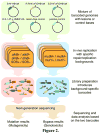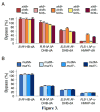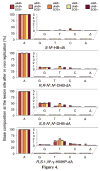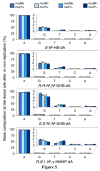1,3-Butadiene-Induced Adenine DNA Adducts Are Genotoxic but Only Weakly Mutagenic When Replicated in Escherichia coli of Various Repair and Replication Backgrounds
- PMID: 28394575
- PMCID: PMC5512570
- DOI: 10.1021/acs.chemrestox.7b00064
1,3-Butadiene-Induced Adenine DNA Adducts Are Genotoxic but Only Weakly Mutagenic When Replicated in Escherichia coli of Various Repair and Replication Backgrounds
Abstract
The adverse effects of the human carcinogen 1,3-butadiene (BD) are believed to be mediated by its DNA-reactive metabolites such as 3,4-epoxybut-1-ene (EB) and 1,2,3,4-diepoxybutane (DEB). The specific DNA adducts responsible for toxic and mutagenic effects of BD, however, have yet to be identified. Recent in vitro polymerase bypass studies of BD-induced adenine (BD-dA) adducts show that DEB-induced N6,N6-DHB-dA (DHB = 2,3-dihydroxybutan-1,4-diyl) and 1,N6-γ-HMHP-dA (HMHP = 2-hydroxy-3-hydroxymethylpropan-1,3-diyl) adducts block replicative DNA polymerases but are bypassed by human polymerases η and κ, leading to point mutations and deletions. In contrast, EB-induced N6-HB-dA (HB = 2-hydroxy-3-buten-1-yl) does not block DNA synthesis and is nonmutagenic. In the present study, we employed a newly established in vivo lesion-induced mutagenesis/genotoxicity assay via next-generation sequencing to evaluate the in vivo biological consequences of S-N6-HB-dA, R,R-N6,N6-DHB-dA, S,S-N6,N6-DHB-dA, and R,S-1,N6-γ-HMHP-dA. In addition, the effects of AlkB-mediated direct reversal repair, MutM and MutY catalyzed base excision repair, and DinB translesion synthesis on the BD-dA adducts in bacterial cells were investigated. BD-dA adducts showed the expected inhibition of DNA replication in vivo but were not substantively mutagenic in any of the genetic environments investigated. This result is in contrast with previous in vitro observations and opens the possibility that E. coli repair and bypass systems other than the ones studied here are able to minimize the mutagenic properties of BD-dA adducts.
Conflict of interest statement
The authors declare no competing financial interest.
Figures





Similar articles
-
Polymerase Bypass of N(6)-Deoxyadenosine Adducts Derived from Epoxide Metabolites of 1,3-Butadiene.Chem Res Toxicol. 2015 Jul 20;28(7):1496-507. doi: 10.1021/acs.chemrestox.5b00166. Epub 2015 Jul 6. Chem Res Toxicol. 2015. PMID: 26098310 Free PMC article.
-
Base Excision Repair of N6-Deoxyadenosine Adducts of 1,3-Butadiene.Biochemistry. 2016 Nov 1;55(43):6070-6081. doi: 10.1021/acs.biochem.6b00553. Epub 2016 Oct 21. Biochemistry. 2016. PMID: 27552084 Free PMC article.
-
DNA oligomers containing site-specific and stereospecific exocyclic deoxyadenosine adducts of 1,2,3,4-diepoxybutane: synthesis, characterization, and effects on DNA structure.Chem Res Toxicol. 2010 Oct 18;23(10):1556-67. doi: 10.1021/tx100146v. Epub 2010 Sep 27. Chem Res Toxicol. 2010. PMID: 20873715 Free PMC article.
-
Insights into the toxicokinetics and toxicodynamics of 1,3-butadiene.Chem Biol Interact. 2001 Jun 1;135-136:599-614. doi: 10.1016/s0009-2797(01)00199-5. Chem Biol Interact. 2001. PMID: 11397415 Review.
-
A review of the genetic and related effects of 1,3-butadiene in rodents and humans.Mutat Res. 2000 Oct;463(3):181-213. doi: 10.1016/s1383-5742(00)00056-9. Mutat Res. 2000. PMID: 11018742 Review.
Cited by
-
Biological Evaluation of DNA Biomarkers in a Chemically Defined and Site-Specific Manner.Toxics. 2019 Jun 25;7(2):36. doi: 10.3390/toxics7020036. Toxics. 2019. PMID: 31242562 Free PMC article. Review.
-
1,3-Butadiene: a ubiquitous environmental mutagen and its associations with diseases.Genes Environ. 2022 Jan 10;44(1):3. doi: 10.1186/s41021-021-00233-y. Genes Environ. 2022. PMID: 35012685 Free PMC article. Review.
-
Diepoxybutane-induced apoptosis is mediated through the ERK1/2 pathway.Hum Exp Toxicol. 2018 Oct;37(10):1080-1091. doi: 10.1177/0960327118755255. Epub 2018 Feb 6. Hum Exp Toxicol. 2018. PMID: 29405768 Free PMC article.
-
Chemical Analysis of DNA Damage.Anal Chem. 2018 Jan 2;90(1):556-576. doi: 10.1021/acs.analchem.7b04247. Epub 2017 Nov 7. Anal Chem. 2018. PMID: 29084424 Free PMC article. Review. No abstract available.
-
7,8-Dihydro-8-oxo-1,N6-ethenoadenine: an exclusively Hoogsteen-paired thymine mimic in DNA that induces A→T transversions in Escherichia coli.Nucleic Acids Res. 2022 Apr 8;50(6):3056-3069. doi: 10.1093/nar/gkac148. Nucleic Acids Res. 2022. PMID: 35234900 Free PMC article.
References
-
- Pelz N, Dempster NM, Shore PR. Analysis of low molecular weight hydrocarbons including 1,3-butadiene in engine exhaust gases using an aluminum oxide porous-layer open-tubular fused-silica column. J Chromatogr Sci. 1990;28:230–235. - PubMed
-
- Hecht SS. Tobacco smoke carcinogens and lung cancer. J Natl Cancer Inst. 1999;91:1194–1210. - PubMed
-
- White WC. Butadiene production process overview. Chem Biol Interact. 2007;166:10–14. - PubMed
-
- Melnick RL, Kohn MC. Mechanistic data indicate that 1,3-butadiene is a human carcinogen. Carcinogenesis. 1995;16:157–163. - PubMed
MeSH terms
Substances
Grants and funding
LinkOut - more resources
Full Text Sources
Other Literature Sources
Research Materials

